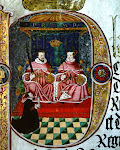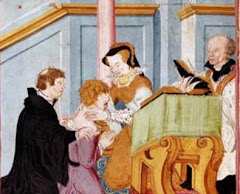
On 1st February 1554, Queen Mary I rode to the Guildhall in London to rally the citizens to her cause against Wyatt’s rebellion. The rebels were advancing to the city and Mary needed to ensure that they were not met with a sympathetic crowd once they got there. She had refused to abandon the city for her own safety, believing that her presence was necessary and that a direct speech to the citizens would prompt demonstrations of loyalty. Though often presented as a queen who lacked political aptitude, Mary’s decision was highly pragmatic. She ‘did so wonderfully enamour the hearts of the hearers as it was world to hear with what shouts they exalted the honour and magnanimity of Queen Mary’, so wrote the contemporary John Proctor in his account of the rebellion [1].

Last month I visited the Guildhall during London’s Open House weekend [2]. The present building dates between 1411 and 1430 though various parts of the structure have been destroyed by the Great Fire of 1666 and by bombing during World War Two (in 1940 monuments, windows and galleries were destroyed in a single night). The Guildhall was restored in 1954.
The Great Hall within was the scene of Mary’s speech to the citizens of London. Her speech began with a denouncement of the actions of Thomas Wyatt and the rebels, presenting their cause as treasonous. She maintained that her decision to marry Philip of Spain was one supported by her Council and that the marriage was to the benefit of the realm. Then, Proctor writes, she stated to the crowd:
“For I am already married to this Common Weal and the faithful members of the same; the spousal ring whereof I have on my finger: which never hitherto was, nor hereafter shall be, left off. Protesting unto you nothing to more acceptable to my heart, nor more answerable to my will, then your advancement in wealth and welfare, with the furtherance of GOD’S glory” [3].
With that, Proctor asserts, Mary stated that owing to her ‘tender and princely heart toward them’, she would remain near ‘and prest adventure the spense [shedding] of her royal blood in defence of them’ [4].
 Those familiar with the reign of Elizabeth I will probably detect the notable similarities between Mary’s speech here and Elizabeth’s speech of 1559 concerning the subject of her marriage, along with the Tilbury Speech of 1588. Just as Mary would use her coronation ring to symbolise the mystical union that bound her to her kingdom so Elizabeth, some five years later, would employ the same technique. Mary however applied this rhetoric in her arguments for the right and necessity of the queen regnant marrying; she did not see her union with the realm being affected by acquiring a husband. Elizabeth would of course adopt the theme of a union in a different manner, by portraying it as a perfectly acceptable alternative to a temporal marriage. Regardless of the differences both had to the approach to marriage, the ‘borrowing’ of rhetoric concerning the subject of the female sovereign’s union with her realm arguably illustrates the lack of originality in Elizabeth’s own speech. It is often presumed that Elizabeth merely learnt from her sister’s mistakes, thus Mary was an example of how a queen regnant ought not to be. The idea that Elizabeth may have taken more positive lessons from her predecessor, including endorsing her points and adapting them to an opposing argument, is one that needs much consideration.
Those familiar with the reign of Elizabeth I will probably detect the notable similarities between Mary’s speech here and Elizabeth’s speech of 1559 concerning the subject of her marriage, along with the Tilbury Speech of 1588. Just as Mary would use her coronation ring to symbolise the mystical union that bound her to her kingdom so Elizabeth, some five years later, would employ the same technique. Mary however applied this rhetoric in her arguments for the right and necessity of the queen regnant marrying; she did not see her union with the realm being affected by acquiring a husband. Elizabeth would of course adopt the theme of a union in a different manner, by portraying it as a perfectly acceptable alternative to a temporal marriage. Regardless of the differences both had to the approach to marriage, the ‘borrowing’ of rhetoric concerning the subject of the female sovereign’s union with her realm arguably illustrates the lack of originality in Elizabeth’s own speech. It is often presumed that Elizabeth merely learnt from her sister’s mistakes, thus Mary was an example of how a queen regnant ought not to be. The idea that Elizabeth may have taken more positive lessons from her predecessor, including endorsing her points and adapting them to an opposing argument, is one that needs much consideration.Aside from Mary’s speech the Great Hall was also the scene of Lady Jane Grey and Archbishop Thomas Cranmer’s trial in 1554, during which both were condemned to death. Today a plaque is placed within the hall listing notable trials from the early modern period that took place at the location:

More pics:



The only window within the Great Hall that survived the bombing. It dates to the fifteenth-century

Remains of a medieval wall in the crypt – believed to be part of the fifteenth-century building

Lovely stained glass window of Thomas More in the east crypt
~~~~~~~~~~~~~~~~~~~~~~~~~~~~~~~~~~
Another version of Mary's Guildhall speech is supplied by John Foxe, and this version has recently been endorsed by Anna Whitelock in her book, Mary Tudor: England's First Queen. The speech Foxe provides is similar in structure to the one provided by Proctor though the language endorsed is dissimilar. I have decided to use Proctor's account given that he was actually in England at the time of Wyatt's rebellion, unlike Foxe. Though Foxe may have been supplied with reliable information regarding the event, and the fact that his account of the speech is so similar to Proctor’s indicates that he was well-informed to a degree, I ultimately feel that Proctor’s firsthand account needs to be consulted. As the Oxford DNB article on Proctor notes that:
‘He was also very close to the events which he described, and his work has always been accepted as an informed source about the events of late January and early February 1554, particularly in Kent.’
(David Loades, ‘Proctor, John (1521–1558)’, Oxford Dictionary of National Biography, Oxford University Press, 2004).
~~~~~~~~~~~~~~~~~~~~~~~~~~~~~~~~~
[1] John Proctor, The Historie of Wyates Rebellion (1554), in David Loades, The Chronicles of the Tudor Queens (Gloucestershire, 2002), p. 36.
[2] For more information on the Guildhall from the Open House London site: http://www.londonopenhouse.org/london/search/factsheet.asp?ftloh_id=1949
[3] Proctor, The Historie of Wyates Rebellion (1554), in Loades, The Chronicles of the Tudor Queens, p. 36.
[4]Ibid.




This comment has been removed by the author.
ReplyDeletei can see how elizabeth I would have learned from the mistakes of mary..it definitely contributed to her being such a powerful leader. wow, can you imagine if the rebellion by wyatt the younger would have followed through? i see it as somewhat of a miracle that the 1543 act of succession managed to follow through and end with such epic greatness!
ReplyDelete